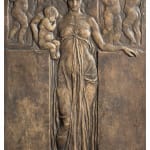

Leonardo Bistolfi Casale Monferrato, 1859-La Loggia (Torino), 1933
Plaque for the Fubine nursery school, ca. 1906
bronze
29 7/8 x 18 1/4 in
76 x 46.5 cm
76 x 46.5 cm
The bronze plaque is one of the first symbolist artworks by Leonardo Bistolfi dating around 1906. It pays tribute to Countess Teresa di Bricherasio Massel for her contribution to the construction of the Fubine nursery school near Alessandria.
The plaque is signed by Bistolfi at the bottom right and remains the only specimen known so far, in addition to the one placed on the facade of the kindergarten and the two plasters preserved at the Gipsoteca Bistolfi in Casale Monferrato. A female figure wrapped in a classical drapery, sweet and sensual at the same time, embraces a child who lovingly leans on her shoulder, consoled by the caresses of the woman. In the background, six dancing and festive children play; arranged in groups of three on the balustrade, they recall Renaissance decorative elements such as Donatello's choir loft.
The whole bas-relief is played with bronze line and surface, offering Liberty novelties on the one hand, and classical echoes on the other through a sublime stiacciato for technical mastery. There is a preparatory drawing of the plaque in one of the Bistolfi notebook. Thanks to this it can be assumed that the artist created this second casting to donate to the Bricherasio family as a demonstration of esteem and to give a proof of his skill. A few years later the same family will have other requests for this great Piedmontese artist.
The plaque is signed by Bistolfi at the bottom right and remains the only specimen known so far, in addition to the one placed on the facade of the kindergarten and the two plasters preserved at the Gipsoteca Bistolfi in Casale Monferrato. A female figure wrapped in a classical drapery, sweet and sensual at the same time, embraces a child who lovingly leans on her shoulder, consoled by the caresses of the woman. In the background, six dancing and festive children play; arranged in groups of three on the balustrade, they recall Renaissance decorative elements such as Donatello's choir loft.
The whole bas-relief is played with bronze line and surface, offering Liberty novelties on the one hand, and classical echoes on the other through a sublime stiacciato for technical mastery. There is a preparatory drawing of the plaque in one of the Bistolfi notebook. Thanks to this it can be assumed that the artist created this second casting to donate to the Bricherasio family as a demonstration of esteem and to give a proof of his skill. A few years later the same family will have other requests for this great Piedmontese artist.

